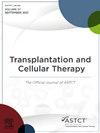Impact of Obesity on GVHD in Patients Undergoing Allogeneic Hematopoietic Cell Transplant for Hematologic Malignancies
IF 3.6
3区 医学
Q2 HEMATOLOGY
引用次数: 0
Abstract
Background
The relationship between obesity and graft-versus-host disease (GVHD) has been studied in both preclinical and clinical studies with varying results.
Objectives
We aimed to investigate the impact of obesity, as measured by body mass index (BMI), on the incidence, severity, and response to therapy of GVHD in a contemporary cohort.
Study Design
We conducted a retrospective study of patients undergoing allogeneic hematopoietic cell transplant (HCT) for acute myelogenous leukemia and myelodysplastic syndrome between January 2010 and December 2021 at the Cleveland Clinic. Incidence, grade, organ involvement, and response to therapy of acute and chronic GVHD were compared between patients with obesity (BMI ≥30) and without obesity. Secondary outcomes included relapse, nonrelapse mortality (NRM), and overall survival (OS).
Results
531 patients were identified, with a median follow-up of 19 months (range, 7-49). Mean (SD) BMI at time of HCT was 29.1 (6.3) kg/m2. There was no significant difference in demographic and HCT characteristics between patients with obesity (N = 199) and without obesity (N = 332). Development of any acute (42% versus 43%) or chronic (29% versus 30%) GVHD was similar in patients with and without obesity. Patients with obesity were less likely to have gastrointestinal involvement from chronic GVHD (28% versus 48%, P = .01). Skin (64% versus 56%), mouth (45% versus 35%) and eye (35% versus 27%) involvements were higher in patients with obesity, although statistically not significant. There were no significant differences in OS, NRM, or relapse.
Conclusion
There were no significant differences in incidence of GVHD among patients with and without obesity. Additional studies are needed to further understand potential differences in organ involvement.
肥胖对接受同种异体造血细胞移植治疗血液恶性肿瘤患者GVHD的影响。
背景:肥胖与移植物抗宿主病(GVHD)之间的关系已经在临床前和临床研究中得到了不同的结果。目的:我们旨在研究肥胖对当代队列GVHD发病率、严重程度和治疗反应的影响,以体重指数(BMI)衡量。研究设计:我们对2010年1月至2021年12月在克利夫兰诊所接受同种异体造血细胞移植(HCT)治疗急性髓性白血病和骨髓增生异常综合征的患者进行了回顾性研究。比较肥胖(BMI≥30)和非肥胖患者急性和慢性GVHD的发病率、分级、器官受累和治疗反应。次要结局包括复发、非复发死亡率(NRM)和总生存期(OS)。结果:531例患者被确定,中位随访19个月(范围7-49)。HCT时BMI平均值(SD)为29.1 (6.3)kg/m2。肥胖患者(N=199)和非肥胖患者(N=332)的人口学和HCT特征无显著差异。任何急性(42%对43%)或慢性(29%对30%)GVHD的发展在有和没有肥胖的患者中是相似的。肥胖患者发生慢性GVHD累及胃肠道的可能性较低(28%比48%,p=0.01)。肥胖患者的皮肤(64%对56%)、口腔(45%对35%)和眼睛(35%对27%)受损伤更高,尽管统计上没有显著性差异。两组在OS、NRM和复发方面无显著差异。结论:肥胖患者与非肥胖患者GVHD的发生率无显著差异。需要进一步的研究来进一步了解器官受累的潜在差异。
本文章由计算机程序翻译,如有差异,请以英文原文为准。
求助全文
约1分钟内获得全文
求助全文
来源期刊

Transplantation and Cellular Therapy
Medicine-Hematology
CiteScore
7.00
自引率
15.60%
发文量
1061
审稿时长
51 days
 求助内容:
求助内容: 应助结果提醒方式:
应助结果提醒方式:


